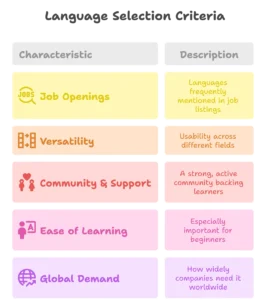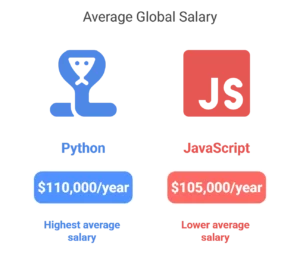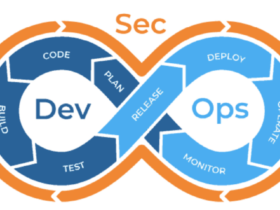Are you wondering which programming languages are worth investing your time in learning?
Whether you’re a beginner or a developer looking to enhance your skills, choosing the right language is a key step in shaping your professional future.
In this article, we’ll highlight the top 6 most in-demand programming languages in today’s job market—based on statistics, hiring trends, developer salaries, and their usage in key fields like AI, web development, and mobile applications.
🔹 1. How Were These Languages Selected?

Before we reveal the list, it’s important to understand the criteria used for ranking these languages. We relied on multiple reputable sources including reports from LinkedIn Jobs, GitHub Trends, the Stack Overflow Developer Survey, and Indeed, along with average global developer salaries and the extent of each language’s adoption by startups and large enterprises.
Criteria:
- Number of job openings : Languages frequently mentioned in job listings.
- Versatility : Usability across different fields (web, AI, apps, games).
- Community and support : A strong, active community backing learners.
- Ease of learning : Especially important for beginners.
- Global demand : How widely companies need it around the world.
🔹 2. The List: Top 6 Most In-Demand Programming Languages
| Rank | Language | Primary Uses | Why It’s in High Demand |
|---|---|---|---|
| 1 | Python | AI, Data Analysis, Web | Easy to learn and vital for future technologies |
| 2 | JavaScript | Interactive Frontend & Web Apps | The backbone of modern web development |
| 3 | Java | Enterprise Applications, Android | Robust, stable, and widely used |
| 4 | TypeScript | Large-scale Web Applications | Enhances JavaScript with better safety and tooling |
| 5 | C# | Games (Unity), Windows Apps | Backed by Microsoft and widely adopted |
| 6 | SQL | Databases, Data Analysis | Essential for any data-driven project |
1. Python
A powerful and highly readable language with wide applications in AI, machine learning, data science, and web development. Frameworks like Django and Flask make it even more versatile.
Learn Python at Real Python or practice with coding problems on LeetCode.
2. JavaScript
The #1 language for frontend web development. Almost every website uses JavaScript. It’s a must-have for any frontend developer and is also used in full-stack and mobile development through frameworks like React and Node.js.
3. Java
Still one of the most widely used languages in enterprise environments. Java is used to build complex business applications and Android apps. Known for its stability, performance, and vast ecosystem.
Learn more from Oracle Java or Codecademy Java Course.
4. TypeScript
A superset of JavaScript with static typing, making code safer and easier to maintain—especially for large-scale applications.
Explore more at the official TypeScript website.
5. C#
A Microsoft-supported language used for building desktop applications, ASP.NET web apps, and games using Unity. It’s strong, relatively easy to learn, and supported by powerful tools like Visual Studio.
Get started with Microsoft Learn for C# or game development on Unity Learn.
6. SQL
Not a traditional programming language, but it’s absolutely essential for managing and querying databases.
Practice SQL using SQLBolt or go through the W3Schools SQL Tutorial.
🔹 3. Detailed Comparison of the Languages

| Language | Ease of Learning | Average Salary (Global) | Usage Areas |
|---|---|---|---|
| Python | Very High | ~$110,000/year | AI, Data, Web |
| JavaScript | Medium | ~$105,000/year | Frontend, Interactive Apps |
| Java | Medium | ~$100,000/year | Android, Enterprise |
| TypeScript | Medium | ~$108,000/year | Large-scale Web Applications |
| C# | Medium | ~$95,000/year | Games, Desktop Apps |
| SQL | Easy | ~$90,000/year | Databases, Data Management |
(Salary sources: Glassdoor, Payscale)
🔹 4. Should You Learn More Than One Language?
Short answer: Yes, but not right away. It’s better to start with one language, build strong foundational knowledge, and then expand into others depending on your interests.
Example Learning Paths :
- Data Developer: Python → SQL → JavaScript
- Frontend Developer: JavaScript → TypeScript → Python (for backend)
- Game Developer: C# → C++ → Python (for AI tools)
The more languages you master, the broader your job opportunities and the wider range of projects you can handle.
Programming languages are like tools—each suited to solving specific problems. If you’re looking for a promising and fast-entry career in tech, learning one of the languages listed above is a smart first step.
Start with the one that aligns with your goals, and don’t hesitate to grow your skills over time. The digital world is constantly evolving, and great programmers are those who learn and adapt.
📎 Share this article with your friends interested in programming, and let us know in the comments: Which programming language do you plan to learn this year?










اترك رد